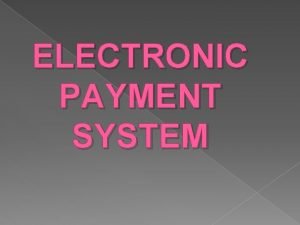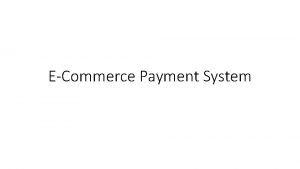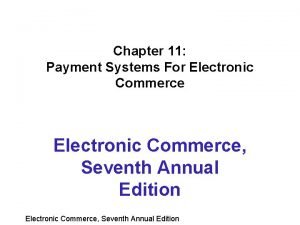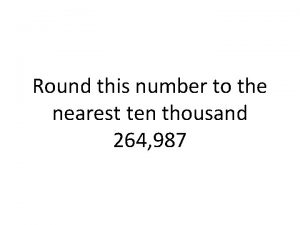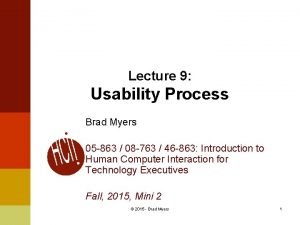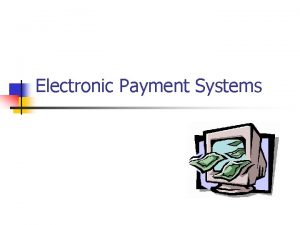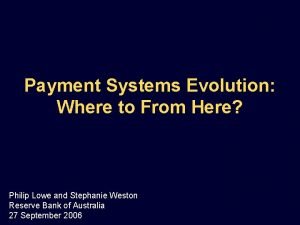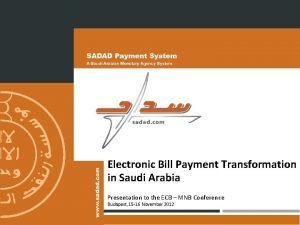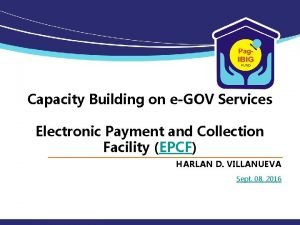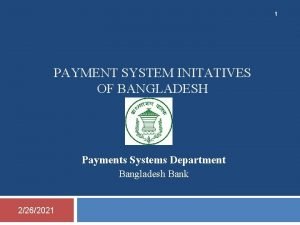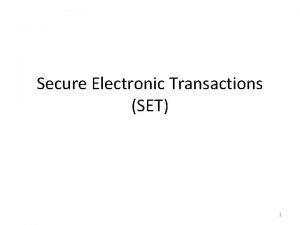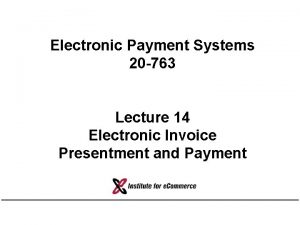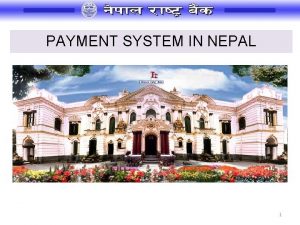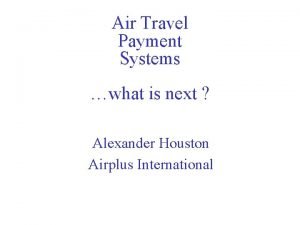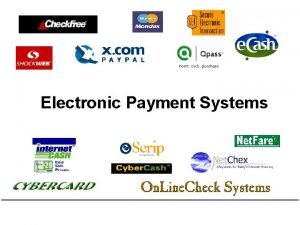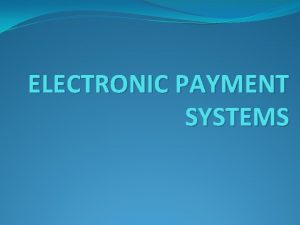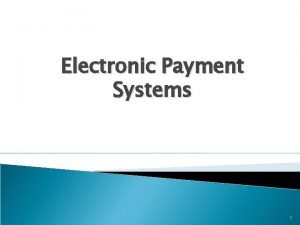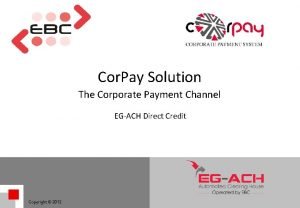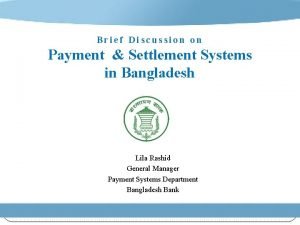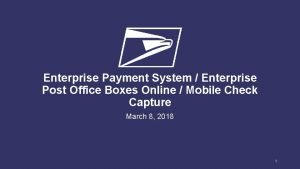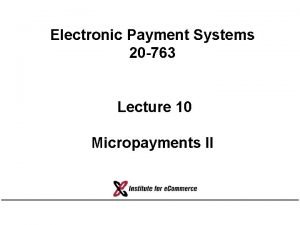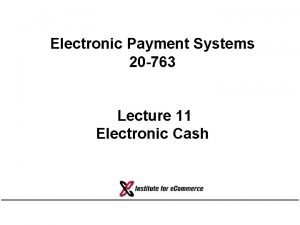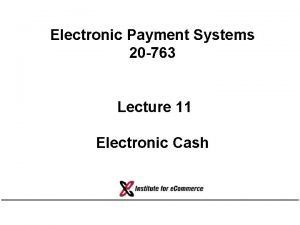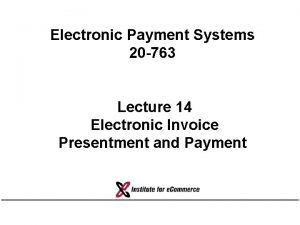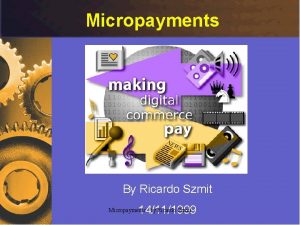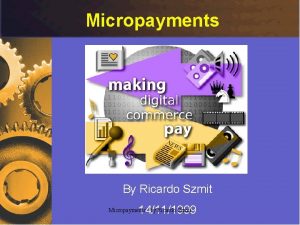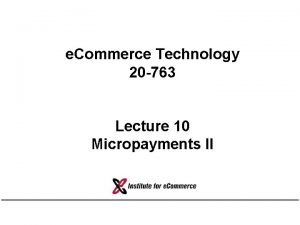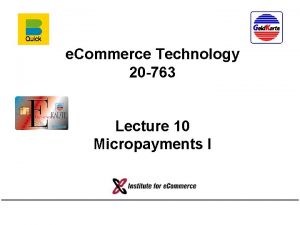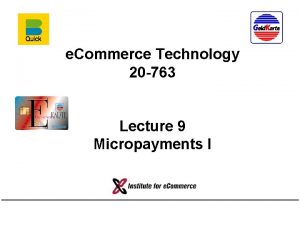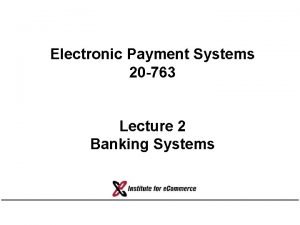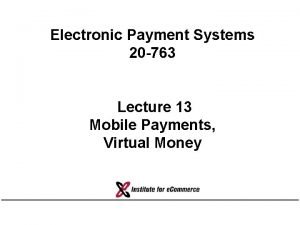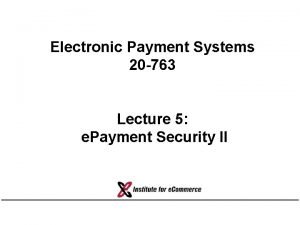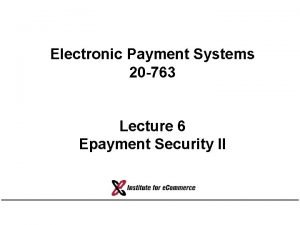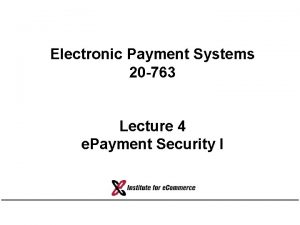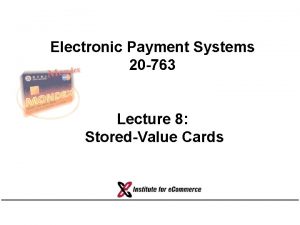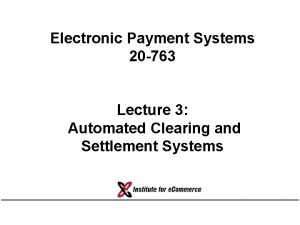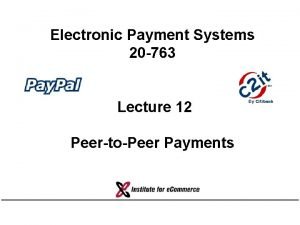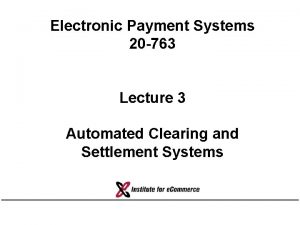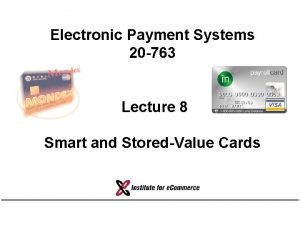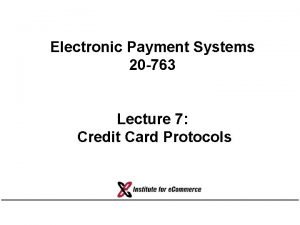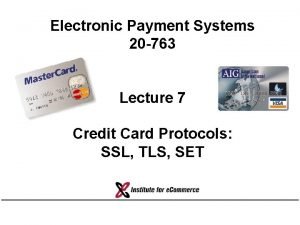Electronic Payment Systems 20 763 Lecture 9 Micropayments




























- Slides: 28

Electronic Payment Systems 20 -763 Lecture 9: Micropayments I

Micropayments • Replacement of cash – Cheaper (cash very expensive to handle) – Electronic moves faster – Easier to count, audit, verify • Small transactions – Beverages – Phone calls – Tolls, transportation, parking – Copying – Internet content – Lotteries, gambling ELECTRONIC PAYMENT SYSTEMS 20 -763 SPRING 2004 COPYRIGHT © 2004 MICHAEL I. SHAMOS

Micropayments • Transactions have low value, e. g. less than $1. 00 • Must process the transaction at low cost • Technological savings: – Don’t verify every transaction – Use symmetric encryption • Float-preserving methods – Prepayment – Grouping • Aggregate purchases (to amortize fixed costs) • Provide float to processor • Partial anonymity (individual purchases disguised) ELECTRONIC PAYMENT SYSTEMS 20 -763 SPRING 2004 COPYRIGHT © 2004 MICHAEL I. SHAMOS

Micropayments • Prepaid cards – Issued by non-banks – Represent call on future service – Not money since usable only with one seller • Electronic purse (wallet) – Issued by bank – Holds representation of real money – In form of a card (for face-to-face or Internet use) – In virtual form (computer file for Internet use) – The two forms are converging, e. g. wireless ELECTRONIC PAYMENT SYSTEMS 20 -763 SPRING 2004 COPYRIGHT © 2004 MICHAEL I. SHAMOS

Electronic Purse Issues • Loading (charging) the purse with money • Making a payment (removing money from the card) • Clearance (getting money into the seller’s account) ELECTRONIC PAYMENT SYSTEMS 20 -763 SPRING 2004 COPYRIGHT © 2004 MICHAEL I. SHAMOS

Geld. Karte • Issued by Zentraler Kreditausschuß (Germany) • Card contains counters representing money value – Max balance 200 EUR = USD 252 • Card is loaded through a loading terminal – Debits customer’s bank account • Spending at merchant terminal or on Internet – Amount deducted from card, added to merchant terminal (card) – No real-time authorization • End-of-day: merchant uploads transactions • Money credited to merchant account • Bank fee: 0. 3%, minimum USD 0. 01 ELECTRONIC PAYMENT SYSTEMS 20 -763 SPRING 2004 COPYRIGHT © 2004 MICHAEL I. SHAMOS

Loading Geld. Karte LOADING TERMINAL (ATM) 2. AUTHORIZATION REQUEST 1. LOAD REQUEST + PIN 8. VALUE TRANSFER 5. AUTHORIZATION 7. SAM EXCHANGE SAM ISSUING BANK LOADING MANAGER 4. AUTHORIZATION 3. AUTHORIZATION REQUEST AUTHORIZATION SERVER SAM 9. OFFLINE FILE TRANSFER 6. UPDATE ACCOUNTS SAM = SECURITY APPLICATION MODULE ACCOUNT DATABASE SOURCE: SHERIF ELECTRONIC PAYMENT SYSTEMS 20 -763 SPRING 2004 COPYRIGHT © 2004 MICHAEL I. SHAMOS

Geld. Karte Payment • Customer inserts Geld. Karte in slot (at merchant terminal or PCMCIA card) • Merchant authenticates customer card OFFLINE • Customer authenticates merchant card (NO THIRD PARTY) • Transfer purchase amount • Generate electronic receipts • (Later) Merchant presents receipt to issuing bank to obtain credit to merchant account • No purse-to-purse transactions ELECTRONIC PAYMENT SYSTEMS 20 -763 SPRING 2004 COPYRIGHT © 2004 MICHAEL I. SHAMOS

Geld. Karte Card Authentication • Merchant SAM generates a random number RAND (to prevent replay attack), sends to customer card with request for customer card ID (CID) • Card sends CID, a generated sequence number SNo, RAND, and H(CID) encrypted with a symmetric secret key SKC (known to card, not customer) • No public-key encryption • Merchant computes SKC from CID and his own secret key SKM (known to card, not merchant) • Merchant can now validate integrity of the card message by computing H(CID) ELECTRONIC PAYMENT SYSTEMS 20 -763 SPRING 2004 COPYRIGHT © 2004 MICHAEL I. SHAMOS

Geld. Karte Value Exchange • Customer sends Start. Payment message • Merchant sends MID, merchant’s transaction number TNo, SNo, a MAC encrypted with SKC, CID and the value M to be transferred, all encrypted with SKC • Customer can decrypt this message with SKC and validate merchant • Customer checks CID, M and SNo (prevent replay) • Customer card verifies at least M remaining, subtracts M, increments SNo, records payment data, generates proof of payment and sends to merchant card: { M, MID, SNo, TNo, ANo, MAC } AMOUNT MERCHANT ID CUSTOMER SEQUENCE # ELECTRONIC PAYMENT SYSTEMS 20 -763 MERCHANT SEQUENCE # SPRING 2004 CUSTOMER ACCOUNT # MESSAGE AUTHENTICATION CODE COPYRIGHT © 2004 MICHAEL I. SHAMOS

Geld. Karte Value Exchange, cont. • Merchant verifies payment: – compute actual payment amount M' from the proof of payment, compare with M – verify MID and TNo – increment TNo, increase balance by M – notify merchant of success – record transaction data with different secret key KZD • Merchant requests payment from bank (later) – sends encrypted proofs of payment to bank – TNo prevents more than one credit per transaction ELECTRONIC PAYMENT SYSTEMS 20 -763 SPRING 2004 COPYRIGHT © 2004 MICHAEL I. SHAMOS

Geld. Karte Clearing • Uses a “shadow account” (Börsenverechnungskonto) to track the contents of the card – When card is loaded, shadow account is credited – When money is spent, shadow account is debited • online transactions immediately • offline transactions later • If card is lost or damaged, money can be replaced • Problem: every transaction is recorded, no anonymity • Solution: “Weisse Karte. ” Bought for cash, not connected to any bank account ELECTRONIC PAYMENT SYSTEMS 20 -763 SPRING 2004 COPYRIGHT © 2004 MICHAEL I. SHAMOS

Geld. Karte Security • DES (customer), triple DES (merchant) (cipher block chaining or cipher feedback mode) • 128 -bit hashes • Each card has unique ID, unique symmetric key, PIN stored in “secret zone” and in bank • Unique transaction numbers ELECTRONIC PAYMENT SYSTEMS 20 -763 SPRING 2004 COPYRIGHT © 2004 MICHAEL I. SHAMOS

Geld. Karte Internet Payment “Caroline” Trusted Wallet Device Geld. Karte Reader USB or Infrared Connection to PC • Wireless potential ELECTRONIC PAYMENT SYSTEMS 20 -763 CASHMOUSE SPRING 2004 COPYRIGHT © 2004 MICHAEL I. SHAMOS

Other Electronic Purses QIANFLEX (CHINA) AUSTRIAN QUICK PRISMERA PEOPLE’S BANK OF CHINA e. PURSE CYBERFLEX JAVA CARD ELECTRONIC PAYMENT SYSTEMS 20 -763 DANMØNT SPRING 2004 COPYRIGHT © 2004 MICHAEL I. SHAMOS

Remote Micropayments • Remote micropayments – Buyer is not physically in seller’s presence – Can’t insert card into vendor’s machine – No physical goods, only information goods • if micropayment will work, goods must be cheap, e. g. $0. 01 – Subscriptions, credit cards, checks, ACH (even Pay. Pal) too expensive • Examples: web pages, stock quotes, news articles, weather report, directory lookup • Need instant service for large numbers of 1¢ transactions + reasonable profit to payment provider ELECTRONIC PAYMENT SYSTEMS 20 -763 SPRING 2004 COPYRIGHT © 2004 MICHAEL I. SHAMOS

Remote Micropayment Parties • Users (buyers) • Vendors (sellers) • Brokers (intermediaries) User Vendor Web Browser Web Server – issue “scrip” (virtual money) to users – redeem scrip from vendors for real money Scrip Broker Server Broker • Assumptions – User-Broker relationship is long-term – Vendor-Broker relationship is long-term – User-Vendor relationship is short-term ELECTRONIC PAYMENT SYSTEMS 20 -763 SPRING 2004 COPYRIGHT © 2004 MICHAEL I. SHAMOS

Micropayment Efficiency • Providers need to process a peak load of at least 2500 transactions/second • Public-key cryptography is expensive – 1 RSA signature verifications = 1000 symmetric encryptions = 10, 000 hashes • Need to minimize Internet traffic – Servers must be up – More servers required, longer queues, lost packet delay – Remove the provider from the process (user + vendor only) • For small payment amounts, perfection is not needed – Losing a micropayment – Keep micropayment fraud low ELECTRONIC PAYMENT SYSTEMS 20 -763 SPRING 2004 COPYRIGHT © 2004 MICHAEL I. SHAMOS

Payword Concept • • • Hash functions are one-way and easy to compute Use them to secure scrip Suppose we need N “coins” Start with a random number WN Hash it N times to form W 0 WN WN-1 = H(WN ) WN-2 = H(WN-1 ) • • • W 1 = H(W 2 ) W 0 = H(W 1 ) • Vendor receives W 0 to start • Each payword is worth one unit • When vendor receives W 53 he verifies it by hashing ELECTRONIC PAYMENT SYSTEMS 20 -763 SPRING 2004 COPYRIGHT © 2004 MICHAEL I. SHAMOS

Payword • Based on “paywords, ” strings that will be accepted by vendors for purchases • User authenticates himself to a broker with one signature verification, establishes means of paying “real” money for paywords • User sets up with broker a linked chain of paywords to be used with a specific vendor. (Linking is used to make authentication of the paywords very cheap. ) • User pays vendor by revealing paywords to vendor • Marginal cost of a payment: one hash computation ELECTRONIC PAYMENT SYSTEMS 20 -763 SPRING 2004 COPYRIGHT © 2004 MICHAEL I. SHAMOS

Payword • User sets up Payword account with a broker (pays real money) • Broker issues user a “virtual card” (certificate) – broker name, user IP address, user public key • Certificate authenticates user to vendor • User creates payword chains (typical length: 100 units) specific to a vendor ELECTRONIC PAYMENT SYSTEMS 20 -763 SPRING 2004 COPYRIGHT © 2004 MICHAEL I. SHAMOS

Buying Paywords • User visits broker over secure channel (e. g. SSL), giving coordinates of bank account or credit card: U, USER NAME A U, USER ADDRESS PKU, USER PUBLIC KEY T U, $U USER CERTIFICATE COORDINATES OF BANK ACCOUNT OR CC • Broker issues a subscription card CU = { B, U, AU, PKU, E, BROKER NAME EXPIRATION DATE IU } SKB USER INFORMATION (CARD #, CREDIT LIMIT) BROKER PRIVATE KEY • Vendor will deliver goods only to AU ELECTRONIC PAYMENT SYSTEMS 20 -763 SPRING 2004 COPYRIGHT © 2004 MICHAEL I. SHAMOS

Making Payment • Commitment to a payword chain = promise by user to pay vendor for all paywords given out by user before E – N = value in jetons needed for purchases (1 payword = 1 jeton) – WN = last payword, a random value chose by user • User creates payword chain backwards by hashing WN WN-1 = H(WN); WN-2 = H(WN-1) = H(H(WN)) , etc. , giving W = { W 0, W 1, . . . WN-1, WN } CAN EASILY COMPUTE THIS WAY DIFFICULT TO COMPUNTE THIS WAY • User “commits” this chain to a vendor, sends M IS VENDOR SPECIFIC AND USER-SPECIFIC (NO USE TO ANYONE ELSE) M = { V, CU, W 0, D, IM } SKU VENDOR NAME “FIRST” PAYWORD ELECTRONIC PAYMENT SYSTEMS 20 -763 EXPIRATION DATE OF COMMITMENT SPRING 2004 EXPENSIVE: REQUIRES DIGITAL SIGNATURE EXTRA INFORMATION (VALUE OF CHAIN) USER PRIVATE KEY COPYRIGHT © 2004 MICHAEL I. SHAMOS

Making Payment, cont. • Vendor can use PKU and PKB to read the commitment to know that U is currently authorized to spend paywords. • User “spends” paywords with the vendor in order W 1 , W 2 , . . . , WN. To spend payword Wi, user sends the vendor the unsigned token P = { Wi, i }. • To verify that P is legitimate, vendor hashes it i times to obtain W 0. If this matches W 0 in the commitment, the payment is good. • If V stores the last payword value seen from U, only one hash is needed. (If last hash was Wi, when vendor receives Wi+1, can hash it once and compare with Wi. ) • P does not have to be signed because hash is one-way. ELECTRONIC PAYMENT SYSTEMS 20 -763 SPRING 2004 COPYRIGHT © 2004 MICHAEL I. SHAMOS

Settlement with Payword • Even if vendor has no relationship with broker B, can still verify user paywords (only need broker’s public key) • For vendor to get money from B requires relationship • Vendor sends broker B a reimbursement request for each user that sent paywords with M, WL (last payword received by vendor) • Broker verifies each commitment using PKU and performs L hashes to go from WL to W 0 • Broker pays V, aggregates commitments of U and bills U’s credit card or debits money from U’s bank account ELECTRONIC PAYMENT SYSTEMS 20 -763 SPRING 2004 COPYRIGHT © 2004 MICHAEL I. SHAMOS

Payword Payment Properties • Payment and verification by vendor are offline (no use of a trusted authority). • Payment token P does not reveal the goods • Fraud by user (issuing paywords without paying for them) will be detected by the broker; loss should be small • Vendor keeps record of unexpired paywords to guard against replay ELECTRONIC PAYMENT SYSTEMS 20 -763 SPRING 2004 COPYRIGHT © 2004 MICHAEL I. SHAMOS

Major Ideas • Micropayment systems must be fast and cheap • They MUST lack features of higher-value payment systems • Use of hashing instead of cryptography • Micropayment parties: buyer, seller, broker • Payword user generates his own coins! • Fraud is not a serious problem with micropayments ELECTRONIC PAYMENT SYSTEMS 20 -763 SPRING 2004 COPYRIGHT © 2004 MICHAEL I. SHAMOS

Q&A ELECTRONIC PAYMENT SYSTEMS 20 -763 SPRING 2004 COPYRIGHT © 2004 MICHAEL I. SHAMOS
 E payment meaning
E payment meaning Electronic payment system examples
Electronic payment system examples Payment systems for electronic commerce
Payment systems for electronic commerce Round the following numbers to the nearest 10
Round the following numbers to the nearest 10 763
763 Objectives of e payment
Objectives of e payment What is eipp
What is eipp Evolution of electronic payment system
Evolution of electronic payment system Benefits of electronic payment system
Benefits of electronic payment system Electronic bill presentation and payment
Electronic bill presentation and payment Epcf enrollment form
Epcf enrollment form Beftn vs npsb
Beftn vs npsb Set secure electronic transaction
Set secure electronic transaction Yodelee
Yodelee Nepal electronic payment system
Nepal electronic payment system 01:640:244 lecture notes - lecture 15: plat, idah, farad
01:640:244 lecture notes - lecture 15: plat, idah, farad Is the electronic exchange of money or scrip
Is the electronic exchange of money or scrip Electronic field production examples
Electronic field production examples Car wash payment systems
Car wash payment systems Cambridge payment systems
Cambridge payment systems Oversignt
Oversignt Travel payment systems
Travel payment systems Payment systems outline
Payment systems outline History of payment systems
History of payment systems Payment systems outline
Payment systems outline Egach
Egach Payment systems and working hours
Payment systems and working hours What is the difference between beftn and npsb
What is the difference between beftn and npsb What is an enterprise payment system
What is an enterprise payment system
